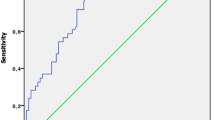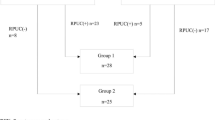Abstract
Purpose
To determine the diagnostic value of computerized tomography (CT) in differentiating pyonephrosis from hydronephrosis on the basis of attenuation values (Hounsfield unit—HU).
Methods
Data of the patients with grades 1–3 hydronephrosis on abdominopelvic CT, who underwent nephrostomy tube placement for decompression of the collecting system, were retrospectively analyzed. Patient demographics and CT findings were recorded along with the first access urine culture results. Three physicians calculated the surface areas and the attenuation values of the dilated collecting systems using the system software. Mean HU of pyonephrosis and hydronephrosis cases was compared.
Results
A total of 105 patients with the mean age of 47.7 ± 15.5 (range 20–80) were included. The interclass correlation coefficient of three physicians was 0.981 for HU measurement and 0.999 for calculation of collecting system surface area. Of the patients, 47 (44.8 %) had pyonephrosis. Mean surface areas of the collecting system were similar in patients with pyonephrosis and hydronephrosis (1481.13 ± 1562.94 vs. 1612.94 ± 2261.4 mm2, p = 0.735). Urine cultures were positive in all patients with pyonephrosis, whereas 12.7 % of hydronephrosis cases had bacterial in first access urine culture. The HU of the patients with pyonephrosis was significantly higher that that of patients with hydronephrosis (13.51 ± 13.29 vs. 4.67 ± 5.37, p = 0.0001). Having a HU of 9.21 or over diagnosed pyonephrosis accurately with 65.96 % sensitivity and 87.93 % specificity.
Conclusion
Measuring attenuation values of the collecting system may be useful to differentiate pyonephrosis from hydronephrosis. Diagnosing pyonephrosis accurately may avoid septic complications.


Similar content being viewed by others
References
Kaplan DM, Rosenfield AT, Smith RC (1997) Advances in the imaging of renal infection: helical CT and modern coordinated imaging. Infect Dis Clin North Am 11:681–705
Browne RF, Zwirewich C, Torreggiani WC (2004) Imaging of urinary tract infection in the adult. EurRadiol 14(suppl):E161–E183
Webb JAW (1997) The role of imaging in adult acute urinary tract infection. EurRadiol 7:837–843
Kenney PJ (1990) Imaging of chronic renal infections. Am J Roentgenol 155:485–494
Wang IK, Chang FR, Yang BY, Lin CL, Huang CC (2003) The use of ultrasonography in evaluating adults with febrile urinary tract infection. Ren Fail 25:981–987
Puech P, Lagard D, Leroy C, Dracon M, Biserte J, Lemaitre L (2004) Imaging in urinary tract infections in adults. J Radiol 85:220–240
Geoghegan T, Govender P, Torreggiani WC (2005) MR urography depiction of fluid-debris levels: a sign of pyonephrosis. AJR Am J Roentgenol 185(2):560
Kawashima A, Sandler CM, Goldman SM, Raval BK, Fishman EK (1997) CT of renal inflammatory disease. Radiographics 17:851–866
Fultz PJ, Hampton WR, Totterman SM (1993) Computed tomography of pyonephrosis. Abdom Imaging 18:82–87
Kawashima A, Sandler CM, Ernst RD, Goldman SM, Raval B, Fishman EK (1997) Renal inflammatory disease: the current role of CT. Crit Rev Diagn Imaging 38:369–415
Hounsfield GN (1980) Computed medical imaging. Nobel lecture, December 8, 1979. J Comput Assist Tomogr 4:665–674
Haaga JR, Miraldi F, Wiesen EJ (2009) Basic CT physics, instrumentation, and parameters for dose management. In: Haaga JR, Boll D (eds) CT and MRI of the whole body, 5th edn. Mosby, St. Louis, pp 2465–2692
Nandalur KR, Hardie AH, Bollampally SR, Parmar JP, Hagspiel KD (2005) Accuracy of computed tomography attenuation values in the characterization of pleural fluid: an ROC study. Acad Radiol 12:987–991
Abramowitz Y, Simanovsky N, Goldstein MS, Hiller N (2009) Pleural effusion: characterization with CT attenuation values and CT appearance. AJR Am J Roentgenol 192:618–623
Cullu N, Kalemci S, Karakas O, EserI Yalcin F, Boyaci FN, Karakas E (2014) Efficacy of CT in diagnosis of transudates and exudates in patients with pleural effusion. Diagn Interv Radiol 20(2):116–120
Allen BC, Barnhart H, Bashir M, Nieman C, Breault S, Jaffe TA (2012) Diagnostic accuracy of intra-abdominal fluid collection characterization in the era of multidetector computed tomography. Am Surg 78(2):185–189
Gnannt R, Fischer MA, Baechler T, Clavien PA, Karlo C, Seifert B, Lesurtel M, Alkadhi H (2015) Distinguishing infected from noninfected abdominal fluid collections after surgery: an imaging, clinical, and laboratory-based scoring system. Invest Radiol 50(1):17–23
Li AC, Regalado SP (2012) Emergent percutaneous nephrostomy for the diagnosis and management of pyonephrosis. Semin Intervent Radiol 29:218–225
McNicholas MM, Griffin JF, Cantwell DF (1991) Ultrasound of the pelvis and renal tract combined with a plain film of abdomen in young women with urinary tract infection: can it replace intravenous urography? A prospective study. Br J Radiol 64:221–224
Yoder IC, Lindfors KK, Pfister RC (1984) Diagnosis and treatment of pyonephrosis. Radiol Clin North Am 22(2):407–414
Gücük A, Uyetürk U (2014) Usefulness of hounsfield unit and density in the assessment and treatment of urinary stones. World J Nephrol 3(4):282–286
Chua ME, Gomez OR, Sapno LD, Lim SL, Morales ML Jr (2014) Use of computed tomography scout film and Hounsfield unit of computed tomography scan in predicting the radio-opacity of urinary calculi in plain kidney, ureter and bladder radiographs. Urol Ann 6(3):218–223
Torricelli FC, Marchini GS, De S, Yamaçake KG, Mazzucchi E, Monga M (2014) Predicting urinary stone composition based on single-energy noncontrast computed tomography: the challenge of cystine. Urology 83(6):1258–1263
Gücük A, Uyetürk U, OztürkU Kemahli E, Yildiz M, Metin A (2012) Does the Hounsfield unit value determined by computed tomography predict the outcome of percutaneous nephrolithotomy? J Endourol 26(7):792–796
Weaver J, Monga M (2014) Extracorporeal shockwave lithotripsy for upper tract urolithiasis. Curr Opin Urol 24(2):168–172
You D, Shim M, Jeong IG, Song C, Kim JK, Ro JY, Hong JH, Ahn H, Kim CS (2011) Multilocular cystic renal cell carcinoma: clinicopathological features and preoperative prediction using multiphase computed tomography. BJU Int 108(9):1444–1449
Davenport MS, Neville AM, Ellis JH, Cohan RH, Chaudhry HS, Leder RA (2011) Diagnosis of renal angiomyolipoma with hounsfield unit thresholds: effect of size of region of interest and nephrographic phase imaging. Radiology 260(1):158–165
Westphalen AC (2012) Diagnosis of renal angiomyolipoma with CT Hounsfield unit thresholds. Radiology 262(1):370–371
Authors’ contribution
E Yuruk was involved in protocol development and data analysis and wrote the manuscript; M Tuken was involved in data collection and data analysis; S Sulejman was involved in data collection and data analysis; A Colakerol was involved in data management and data analysis; EC Serefoglu was involved in protocol development and edited the manuscript; K Sarica edited the manuscript; AY Muslumanoglu edited the manuscript.
Author information
Authors and Affiliations
Corresponding author
Ethics declarations
Conflict of interest
The authors declare that they have no conflict of interest.
Ethical approval
All procedures performed in studies involving human participants were in accordance with the ethical standards of the institutional and/or national research committee and with the 1964 Helsinki Declaration and its later amendments or comparable ethical standards. For this type of study, formal consent is not required. All applicable international, national and/or institutional guidelines for the care and use of animals were followed.
Informed consent
Informed consent was obtained from all individual participants included in the study.
Rights and permissions
About this article
Cite this article
Yuruk, E., Tuken, M., Sulejman, S. et al. Computerized tomography attenuation values can be used to differentiate hydronephrosis from pyonephrosis. World J Urol 35, 437–442 (2017). https://doi.org/10.1007/s00345-016-1888-1
Received:
Accepted:
Published:
Issue Date:
DOI: https://doi.org/10.1007/s00345-016-1888-1




